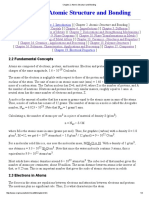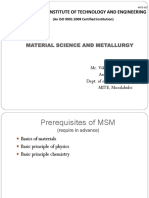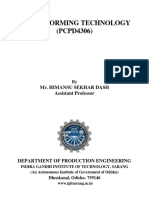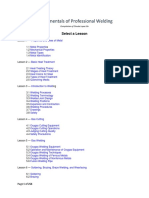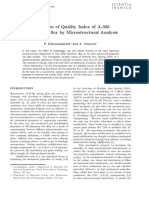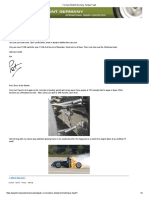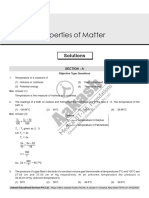Chapter 16. Polymers
Chapter 16. Polymers
Uploaded by
AnonCopyright:
Available Formats
Chapter 16. Polymers
Chapter 16. Polymers
Uploaded by
AnonOriginal Description:
Copyright
Available Formats
Share this document
Did you find this document useful?
Is this content inappropriate?
Copyright:
Available Formats
Chapter 16. Polymers
Chapter 16. Polymers
Uploaded by
AnonCopyright:
Available Formats
3/10/2016
Chapter16.Polymers.Characteristics,ApplicationsandProcessing
Chapter16.Polymers.Characteristics,
ApplicationsandProcessing
[Home][Up][Chapter1.Introduction][Chapter2.AtomicStructureandBonding]
[Chapter3.StructureofCrystals][Chapter4.Imperfections][Chapter5.Diffusion]
[Chapter6.MechanicalPropertiesofMetals][Chapter7.DislocationsandStrengtheningMechanisms]
[Chapter8.Failure][Chapter9.PhaseDiagrams][Chapter10:PhaseTransformationsinMetals]
[Chapter11.ThermalProcessingofMetalAlloys][Chapter13.CeramicsStructuresandProperties]
[Chapter14.CeramicsApplicationsandProcessing][Chapter15.PolymerStructures]
[Chapter16.Polymers.Characteristics,ApplicationsandProcessing][Chapter17.Composites]
[Chapter19.ElectricalProperties]
16.1Introduction
16.2StressStrainBehavior
Thedescriptionofstressstrainbehaviorissimilartothatofmetals,butaveryimportantconsideration
forpolymersisthatthemechanicalpropertiesdependonthestrainrate,temperature,andenvironmental
conditions.
Thestressstrainbehaviorcanbebrittle,plasticandhighlyelastic(elastomericorrubberlike),seeFig.
16.1.Tensilemodulus(modulus)andtensilestrengthsareordersofmagnitudesmallerthanthoseof
metals,butelongationcanbeupto1000%insomecases.Thetensilestrengthisdefinedatthefracture
point(Fig.16.2)andcanbelowerthantheyieldstrength.
Mechanicalpropertieschangedramaticallywithtemperature,goingfromglasslikebrittlebehaviorat
lowtemperatures(likeintheliquidnitrogendemonstration)toarubberlikebehaviorathigh
temperatures(Fig.16.3).
Ingeneral,decreasingthestrainratehasthesameinfluenceonthestrainstrengthcharacteristicsas
increasingthetemperature:thematerialbecomessofterandmoreductile.
16.3DeformationofSemicrystallinePolymers
Manysemicrystallinepolymershavethespheruliticstructureanddeforminthefollowingsteps(Fig.
16.4):
elongationofamorphoustiechains
tiltingoflamellarchainfoldstowardsthetensiledirection
separationofcrystallineblocksegments
orientationofsegmentsandtiechainsinthetensiledirection
Themacroscopicdeformationinvolvesanupperandloweryieldpointandnecking.Unlikethecaseof
metals,theneckgetsstrongersincethedeformationalignsthechainssoincreasingthetensilestressleads
tothegrowthoftheneck.(Fig.16.5).
http://www.virginia.edu/bohr/mse209/chapter16.htm
1/4
3/10/2016
Chapter16.Polymers.Characteristics,ApplicationsandProcessing
16.4FactorsthatInfluencetheMechanicalPropertiesofPolymers
Thetensilemodulusdecreaseswithincreasingtemperatureordiminishingstrainrate.
Obstaclestothestepsmentionedin16.4strengthenthepolymer.Examplesarecrosslinking(aligned
chainshavemorevanderWaalsinterchainbonds)andalargemass(longermoleculeshavemoreinter
chainbonds).Crystallinityincreasesstrengthasthesecondarybondingisenhancedwhenthemolecular
chainsarecloselypackedandparallel.Predeformationbydrawing,analogoustostrainhardeningin
metals,increasesstrengthbyorientingthemolecularchains.Forundrawnpolymers,heatingincreases
thetensilemodulusandyieldstrength,andreducestheductilityoppositeofwhathappensinmetals.
16.5Crystallization,Melting,andGlassTransitionPhenomena
CrystallizationratesaregovernedbythesametypeofScurveswesawinthecaseofmetals(Fig.16.7).
Nucleationbecomesslowerathighertemperatures.
Themeltingbehaviorofsemicrystallinepolymersisintermediatebetweenthatofcrystallinematerials
(sharpdensitychangeatameltingtemperature)andthatofapureamorphousmaterial(slightchangein
slopeofdensityattheglasstransitiontemperature).Theglasstransitiontemperatureisbetween0.5and
0.8ofthemeltingtemperature.
Themeltingtemperatureincreaseswiththerateofheating,thicknessofthelamellae,anddependsonthe
temperatureatwhichthepolymerwascrystallized.
Meltinginvolvesbreakingoftheinterchainbonds,sotheglassandmeltingtemperaturesdependon:
chainstiffness(e.g.,singlevs.doublebonds)
size,shapeofsidegroups
sizeofmolecule
sidebranches,defects
crosslinking
Rigidchainshavehighermeltingtemperatures.
16.6ThermoplasticandThermosettingPolymers
Thermoplasticpolymers(thermoplasts)softenreversiblywhenheated(hardenwhencooledback)
Thermosettingpolymers(thermosets)hardenpermanentlywhenheated,ascrosslinkinghinderbending
androtations.Thermosetsareharder,moredimensionallystable,andmorebrittlethanthermoplasts.
16.7Viscoelasticity
Atlowtemperatures,amorphouspolymersdeformelastically,likeglass,atsmallelongation.Athigh
temperaturesthebehaviorisviscous,likeliquids.Atintermediatetemperatures,thebehavior,likea
rubberysolid,istermedviscoelastic.
Viscoelasticityischaracterizedbytheviscoelasticrelaxationmodulus
Er=(t)/0.
Ifthematerialisstrainedtoavalue0.itisfoundthatthestressneedstobereducedwithtimetomaintain
http://www.virginia.edu/bohr/mse209/chapter16.htm
2/4
3/10/2016
Chapter16.Polymers.Characteristics,ApplicationsandProcessing
thisconstantvalueofstrain(seefigs.16.11and16.12).
Inviscoelasticcreep,thestressiskeptconstantat0andthechangeofdeformationwithtimet)is
measured.Thetimedependentcreepmodulusisgivenby
Ec=0/(t).
16.8DeformationandElastomers
Elastomerscanbedeformedtoverylargestrainsandthespringbackelasticallytotheoriginallength,a
behaviorfirstobservedinnaturalrubber.Elasticelongationisduetouncoiling,untwistingand
straighteningofchainsinthestressdirection.
Tobeelastomeric,thepolymerneedstomeetseveralcriteria:
mustnotcrystallizeeasily
haverelativelyfreechainrotations
delayedplasticdeformationbycrosslinking(achievedbyvulcanization).
beabovetheglasstransitiontemperature
16.9FractureofPolymers
Asothermechanicalproperties,thefracturestrengthofpolymersismuchlowerthanthatofmetals.
Fracturealsostartswithcracksatflaws,scratches,etc.Fractureinvolvesbreakingofcovalentbondsin
thechains.Thermoplastscanhavebothbrittleandductilefracturebehaviors.Glassythermosetshave
brittlefractureatlowtemperaturesandductilefractureathightemperatures.
Glassythremoplastsoftensuffergrazingbeforebrittlefracture.Crazesareassociatedwithregionsof
highlylocalizedyieldingwhichleadstotheformationofinterconnectedmicrovoids(Fig.16.15).Crazing
absorbsenergythusincreasingthefracturestrengthofthepolymer.
16.10MiscellaneousCharacteristics
Polymersarebrittleatlowtemperaturesandhavelowimpactstrengths(IzodorCharpytests),anda
brittletoductiletransitionoveranarrowtemperaturerange.
Fatigueissimilartothecaseofmetalsbutatreducedloadsandismoresensitivetofrequencydueto
heatingwhichleadstosoftening.
16.11Polymerization
Polymerizationisthesynthesisofhighpolymersfromrawmaterialslikeoilorcoal.Itmayoccurby:
addition(chainreaction)polymerization,wheremonomerunitsareattachedoneatatime
condensationpolymerization,bystepwiseintermolecularchemicalreactionsthatproducethemer
units.
16.1216.14notcovered
16.15Elastomers
http://www.virginia.edu/bohr/mse209/chapter16.htm
3/4
3/10/2016
Chapter16.Polymers.Characteristics,ApplicationsandProcessing
Invulcanization,crosslinkingoftheelastomericpolymerisachievedbyanirreversiblechemicalreaction
usuallyathightemperatures(hencevulcan),andusuallyinvolvingtheadditionofsulfurcompounds.
TheSatomsaretheonesthatformthebridgecrosslinks.Elastomersarethermosettingduetothecross
linking.
Rubbersbecomeharderandextendlesswithincreasingsulfurcontent.Forautomobileapplications,
syntheticrubbersarestrengthenedbyaddingcarbonblack.
Insiliconerubbers,thebackboneCatomsarereplacedbyachainofalternatingsiliconandoxygen
atoms.TheseelastomersarealsocrosslinkedandarestabletohighertemperaturesthanCbased
elastomers.
16.1616.18notcovered
Terms:
Additionpolymerization
Condensationpolymerization
Elastomer
Glasstransitiontemperature
Plastic
Relaxationmodulus
Thermoplasticpolymer
Thermoplasticelastomer
Thermosettingpolymer
Ultrahighmolecularweightpolyethylene
Viscoelasticity
Vulcanization
http://www.virginia.edu/bohr/mse209/chapter16.htm
4/4
You might also like
- Modelingof Worm GearDocument12 pagesModelingof Worm Gearkarthik venkatachalamNo ratings yet
- Exam 2 PDFDocument6 pagesExam 2 PDFMustafa Abd ElhamidNo ratings yet
- Chapter 13. Ceramics Structures and Properties: Home Up Chapter 1. IntroductionDocument3 pagesChapter 13. Ceramics Structures and Properties: Home Up Chapter 1. IntroductionAnonNo ratings yet
- Chapter 14. Ceramics Applications and Processing: Home Up Chapter 1. IntroductionDocument2 pagesChapter 14. Ceramics Applications and Processing: Home Up Chapter 1. IntroductionAnonNo ratings yet
- SDF 2 FDFDocument4 pagesSDF 2 FDFAnonNo ratings yet
- Chapter 10: Phase Transformations in Metals: 10.1 IntroductionDocument3 pagesChapter 10: Phase Transformations in Metals: 10.1 IntroductionAnonNo ratings yet
- ME 221 - Structural Materials (Section S2)Document2 pagesME 221 - Structural Materials (Section S2)Prayas JainNo ratings yet
- Aam Materials 4 Microstructure and PropertiesDocument29 pagesAam Materials 4 Microstructure and PropertiesIvanNo ratings yet
- Engineering Material AssignmentDocument3 pagesEngineering Material AssignmentSharjeel Faisal100% (1)
- Exhaustive Question Bank-AMDocument5 pagesExhaustive Question Bank-AMaerolab instructor100% (1)
- Tentative Course Outlin1Document1 pageTentative Course Outlin1azizieh5701No ratings yet
- Metals: Role of Chemical Composition in Corrosion of Aluminum AlloysDocument13 pagesMetals: Role of Chemical Composition in Corrosion of Aluminum AlloysR JNo ratings yet
- Me F213 1081Document4 pagesMe F213 1081jeevang4912No ratings yet
- Mangalore Institute of Technology and Engineering: Material Science and MetallurgyDocument203 pagesMangalore Institute of Technology and Engineering: Material Science and MetallurgyNISHAANTH S 1861462No ratings yet
- Tensile and Fatigue of Al2o3Document10 pagesTensile and Fatigue of Al2o3Samuel ManoharNo ratings yet
- q11 21Document2 pagesq11 21Jaquelyn Dela VictoriaNo ratings yet
- Effect of Radial Forging On The Microstructure and Mechanical Properties of Ti-Based AlloysDocument12 pagesEffect of Radial Forging On The Microstructure and Mechanical Properties of Ti-Based AlloysWolfgang GruberNo ratings yet
- RGPVDocument77 pagesRGPVbhagwatmeena8839829058No ratings yet
- Material ScienceDocument4 pagesMaterial Sciencedablupaul0139No ratings yet
- Metallurgy AssignmentDocument10 pagesMetallurgy Assignmentbezag9905No ratings yet
- Paper Procesos Deformacion PlasticaDocument12 pagesPaper Procesos Deformacion PlasticaJorge BNo ratings yet
- Copper Content and Cooling Rate EffectsDocument6 pagesCopper Content and Cooling Rate EffectsDACAMOGO DCMGNo ratings yet
- Metal Forming Technology 1601913164Document12 pagesMetal Forming Technology 1601913164jesssepinkman03No ratings yet
- Project Report ON Metal Casting Technology Titled Stir Casting of Aluminum-6063 and Graphite PowderDocument18 pagesProject Report ON Metal Casting Technology Titled Stir Casting of Aluminum-6063 and Graphite PowderSherinNo ratings yet
- Mete 222 Introduction To Materials Science & Engineering: Course Objective... You Will Learn AboutDocument18 pagesMete 222 Introduction To Materials Science & Engineering: Course Objective... You Will Learn Aboutaydn_89No ratings yet
- Metallurgy and Material Science - Module 1Document36 pagesMetallurgy and Material Science - Module 1Devasivan Csr100% (1)
- Part 2 - Engineering ReportDocument10 pagesPart 2 - Engineering Reportkvidiniotis99No ratings yet
- Shape Memory AlloyDocument7 pagesShape Memory Alloyphutd09No ratings yet
- 09Document9 pages09Vincent RompiesNo ratings yet
- Metallurgy Question Bank - Questions OnlyDocument6 pagesMetallurgy Question Bank - Questions OnlyMANYAM. HARI KRISHNA MECHANICAL ENGINEERINGNo ratings yet
- Chapter 3Document25 pagesChapter 3Abel JacobNo ratings yet
- 25-Very Important Fatigue Behaviors of Resistance Spot Welds For 980 MPa Grade TRIP Steel-1Document13 pages25-Very Important Fatigue Behaviors of Resistance Spot Welds For 980 MPa Grade TRIP Steel-1hakimshredderNo ratings yet
- Me209 Mechanical Properties of Structural Materials PDFDocument4 pagesMe209 Mechanical Properties of Structural Materials PDFjishnuNo ratings yet
- Fundamentals of Professional Welding PDFDocument256 pagesFundamentals of Professional Welding PDFclaudelgo100% (1)
- Fabrication and Characterization of Iron Aluminide Reinforced Aluminiun Matrix CompositeDocument48 pagesFabrication and Characterization of Iron Aluminide Reinforced Aluminiun Matrix CompositepratyaygeminiNo ratings yet
- Mono74 6Document47 pagesMono74 6Mihaela DenisaNo ratings yet
- CH 6604 Materials Science and Technology Part B Questions Unit IDocument3 pagesCH 6604 Materials Science and Technology Part B Questions Unit Ichitra123No ratings yet
- ME6403-Engineering Materials and Metallurgy Question BankDocument10 pagesME6403-Engineering Materials and Metallurgy Question BankmeganathanNo ratings yet
- Magnesium Matrix Composites Machining Aspects: A ReviewDocument11 pagesMagnesium Matrix Composites Machining Aspects: A ReviewAnil KumarNo ratings yet
- Assignment Questions Set - 4 (Module 4)Document1 pageAssignment Questions Set - 4 (Module 4)nkar037No ratings yet
- Evaluation of Quality Index of A-356 Aluminum Alloy by Microstructural AnalysisDocument6 pagesEvaluation of Quality Index of A-356 Aluminum Alloy by Microstructural AnalysisRegina Maulydia KarekaNo ratings yet
- Improvement of Al-6061 Alloys Mechanical Properties by Controlling Processing ParametersDocument6 pagesImprovement of Al-6061 Alloys Mechanical Properties by Controlling Processing ParametersharieduidNo ratings yet
- The Physical PropertiesDocument4 pagesThe Physical PropertiesAbhijeet DashNo ratings yet
- IJET Paper Word Template A4 V5Document16 pagesIJET Paper Word Template A4 V5KishoreDamodharanNo ratings yet
- 03.table of ContentsDocument9 pages03.table of ContentsdrpigaNo ratings yet
- me212TEST2 2014 2015A-1-1Document12 pagesme212TEST2 2014 2015A-1-1Yohanis BonifaceNo ratings yet
- Engineering Metallurgy IAE III QP Question BankDocument2 pagesEngineering Metallurgy IAE III QP Question BankJawaharNo ratings yet
- Unit 5Document56 pagesUnit 5JAYARAMAN S J (RA2011023010003)No ratings yet
- Em TopicsDocument2 pagesEm Topicskrish2005yahooNo ratings yet
- Unit 1: Two MarksDocument5 pagesUnit 1: Two MarksAravind PhoenixNo ratings yet
- Materials Science and Materials EngineeringDocument16 pagesMaterials Science and Materials EngineeringWanasisYenantaNo ratings yet
- Page 1 of 59Document59 pagesPage 1 of 59Wilfharry billyNo ratings yet
- Parshva Classes: A New Name of 'Guru Classes 'Document2 pagesParshva Classes: A New Name of 'Guru Classes 'Mehul MunshiNo ratings yet
- Metallography Report MSE311Document11 pagesMetallography Report MSE311sumrusubasiNo ratings yet
- Processing and Characterisation of Particulate Reinforced Aluminium Silicon Matrix CompositeDocument6 pagesProcessing and Characterisation of Particulate Reinforced Aluminium Silicon Matrix Compositemas hanNo ratings yet
- Fundamentals of Metal Forming ProcessesDocument23 pagesFundamentals of Metal Forming ProcessesVinayak Bhustalimath50% (2)
- Me6403 Engineering Materials and Metallurgy: Unit 1.alloys and Phase Diagram Part ADocument6 pagesMe6403 Engineering Materials and Metallurgy: Unit 1.alloys and Phase Diagram Part Ajamunaa83No ratings yet
- DURALCAN Geiler ParraDocument3 pagesDURALCAN Geiler ParraGeiler ParraNo ratings yet
- Lec 1Document10 pagesLec 145151ttt.a5No ratings yet
- Polymer Morphology: Principles, Characterization, and ProcessingFrom EverandPolymer Morphology: Principles, Characterization, and ProcessingNo ratings yet
- Physics Exit Exam ReviewDocument18 pagesPhysics Exit Exam ReviewCha Castillo100% (1)
- How To PDFDocument5 pagesHow To PDFAnonNo ratings yet
- DGDHDocument1 pageDGDHAnonNo ratings yet
- Cockpit Control Forces - or - How Robust Do Driver Controls Really Need To Be?Document2 pagesCockpit Control Forces - or - How Robust Do Driver Controls Really Need To Be?AnonNo ratings yet
- Steve's Box (Of Tricks) : Category: Pat S CornerDocument2 pagesSteve's Box (Of Tricks) : Category: Pat S CornerAnonNo ratings yet
- Tempus Fugit: Category: Pat S CornerDocument2 pagesTempus Fugit: Category: Pat S CornerAnonNo ratings yet
- The Summer of 2012: Category: Pat S CornerDocument3 pagesThe Summer of 2012: Category: Pat S CornerAnonNo ratings yet
- DfvadfDocument2 pagesDfvadfAnonNo ratings yet
- How The Judges Learn About This Stuff: Category: Pat S CornerDocument2 pagesHow The Judges Learn About This Stuff: Category: Pat S CornerAnonNo ratings yet
- Formula Student - Education or Motorsport?: Category: Pat S CornerDocument3 pagesFormula Student - Education or Motorsport?: Category: Pat S CornerAnonNo ratings yet
- Formula Student Germany - Chassis Stiffness and Compliance PDFDocument2 pagesFormula Student Germany - Chassis Stiffness and Compliance PDFAnonNo ratings yet
- Design Judging Stuff: Category: Pat S CornerDocument2 pagesDesign Judging Stuff: Category: Pat S CornerAnonNo ratings yet
- AsdgewasadfDocument1 pageAsdgewasadfAnonNo ratings yet
- Chassis Stiffness and Compliance: Category: Pat S CornerDocument2 pagesChassis Stiffness and Compliance: Category: Pat S CornerAnonNo ratings yet
- Eto Yung Genesis SolverDocument11 pagesEto Yung Genesis SolverAnonNo ratings yet
- Laboratory Requirements: 3 Term 2015-2016Document8 pagesLaboratory Requirements: 3 Term 2015-2016AnonNo ratings yet
- Nptel ReboilerDocument8 pagesNptel ReboilerGurubasavaraju T MNo ratings yet
- Introductory Physics 101 Test 5 Review SheetDocument2 pagesIntroductory Physics 101 Test 5 Review SheetSeljen AceNo ratings yet
- Electrostatic Potential: Previous Year Examination Questions 1 Mark QuestionsDocument18 pagesElectrostatic Potential: Previous Year Examination Questions 1 Mark QuestionsAditya PanditNo ratings yet
- Seismic Waves AnalysisDocument6 pagesSeismic Waves Analysisbabu1434No ratings yet
- Thermodynamics: Conservation of Mass Practice ProblemsDocument2 pagesThermodynamics: Conservation of Mass Practice ProblemsAlan100% (1)
- Forces at RestDocument67 pagesForces at RestOdaneNo ratings yet
- CHE 411 Lesson 4 NoteDocument38 pagesCHE 411 Lesson 4 NoteDavid AkomolafeNo ratings yet
- Chapter 10 Relative Equilibrium On FluidsDocument42 pagesChapter 10 Relative Equilibrium On FluidsJubillee Magsino0% (1)
- 08E. Drill String ComponentsDocument153 pages08E. Drill String ComponentsDonald StraubNo ratings yet
- Sumanta Chowdhury - CLS - Aipmt-15-16 - XIII - Phy - Study-Package-3 - Set-1 - Chapter-11 PDFDocument34 pagesSumanta Chowdhury - CLS - Aipmt-15-16 - XIII - Phy - Study-Package-3 - Set-1 - Chapter-11 PDFNikhil ChauhanNo ratings yet
- B. Can A Buried Natural Gas Pipeline Buckle Locally During Earthquake Ground ShakingDocument19 pagesB. Can A Buried Natural Gas Pipeline Buckle Locally During Earthquake Ground ShakingJaime SeguraNo ratings yet
- Effect of Plans Configurations On The Seismic Behaviour of The Structure by Response Spectrum MethodDocument5 pagesEffect of Plans Configurations On The Seismic Behaviour of The Structure by Response Spectrum MethodRacharla Narasimha Raju VarmaNo ratings yet
- Y S KX: (Total 1 Mark)Document5 pagesY S KX: (Total 1 Mark)Romeo SiriguNo ratings yet
- Stretch Forming JomyDocument33 pagesStretch Forming JomyJoNo ratings yet
- EXPERIMENT 4: NMR Analysis of A Constitutional IsomerDocument18 pagesEXPERIMENT 4: NMR Analysis of A Constitutional IsomerDhiyyah Mardhiyyah100% (2)
- Finite Element Method 2017 BatchDocument64 pagesFinite Element Method 2017 BatchSarah BardiNo ratings yet
- l2 160608204411Document8 pagesl2 160608204411Gustavo DalPaiNo ratings yet
- L9-High Pressure VLE - EOSDocument79 pagesL9-High Pressure VLE - EOS13670319No ratings yet
- Solar System Formation HypoDocument2 pagesSolar System Formation HypoTrisha MaguikayNo ratings yet
- Verification of 2D Heat Transfer Models Developed in LS-DYNA For Structural Fire Engineering ApplicationsDocument9 pagesVerification of 2D Heat Transfer Models Developed in LS-DYNA For Structural Fire Engineering ApplicationsJaleel ClaasenNo ratings yet
- Heat Transfer Analysis Of: Compact Heat Exchangers Using Standard CurvesDocument4 pagesHeat Transfer Analysis Of: Compact Heat Exchangers Using Standard CurvesfbahsiNo ratings yet
- Excel Piglet ManualDocument25 pagesExcel Piglet ManualChristo DunstonNo ratings yet
- Chemical Engineering Thermodynamics: Vapor/Liquid EquilibriumDocument61 pagesChemical Engineering Thermodynamics: Vapor/Liquid EquilibriumamelNo ratings yet
- Thermostat Algorithms For Molecular Dynamics Simulations: Phil@igc - Phys.chem - Ethz.chDocument45 pagesThermostat Algorithms For Molecular Dynamics Simulations: Phil@igc - Phys.chem - Ethz.chrishadforuNo ratings yet
- DSM2022 Homework 02Document3 pagesDSM2022 Homework 02João CelestinoNo ratings yet
- Vibration Analysis of Electric AutoDocument11 pagesVibration Analysis of Electric AutoAzinoNo ratings yet
- PHD Thesis MathDocument241 pagesPHD Thesis MathhungkgNo ratings yet
- Msci406 Sols05 PDFDocument3 pagesMsci406 Sols05 PDFEryWiyadi100% (1)





